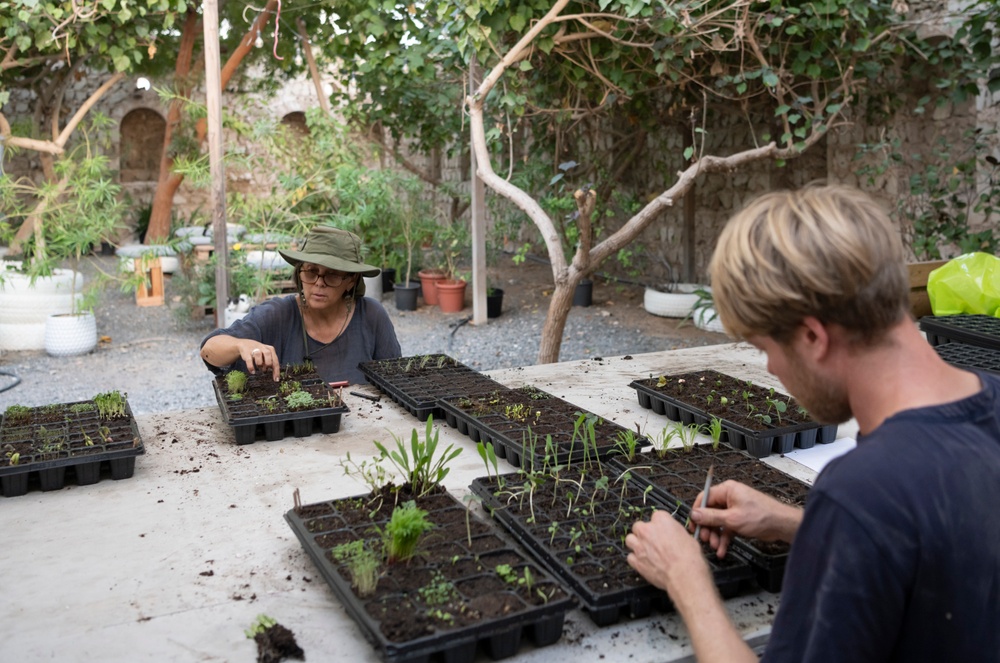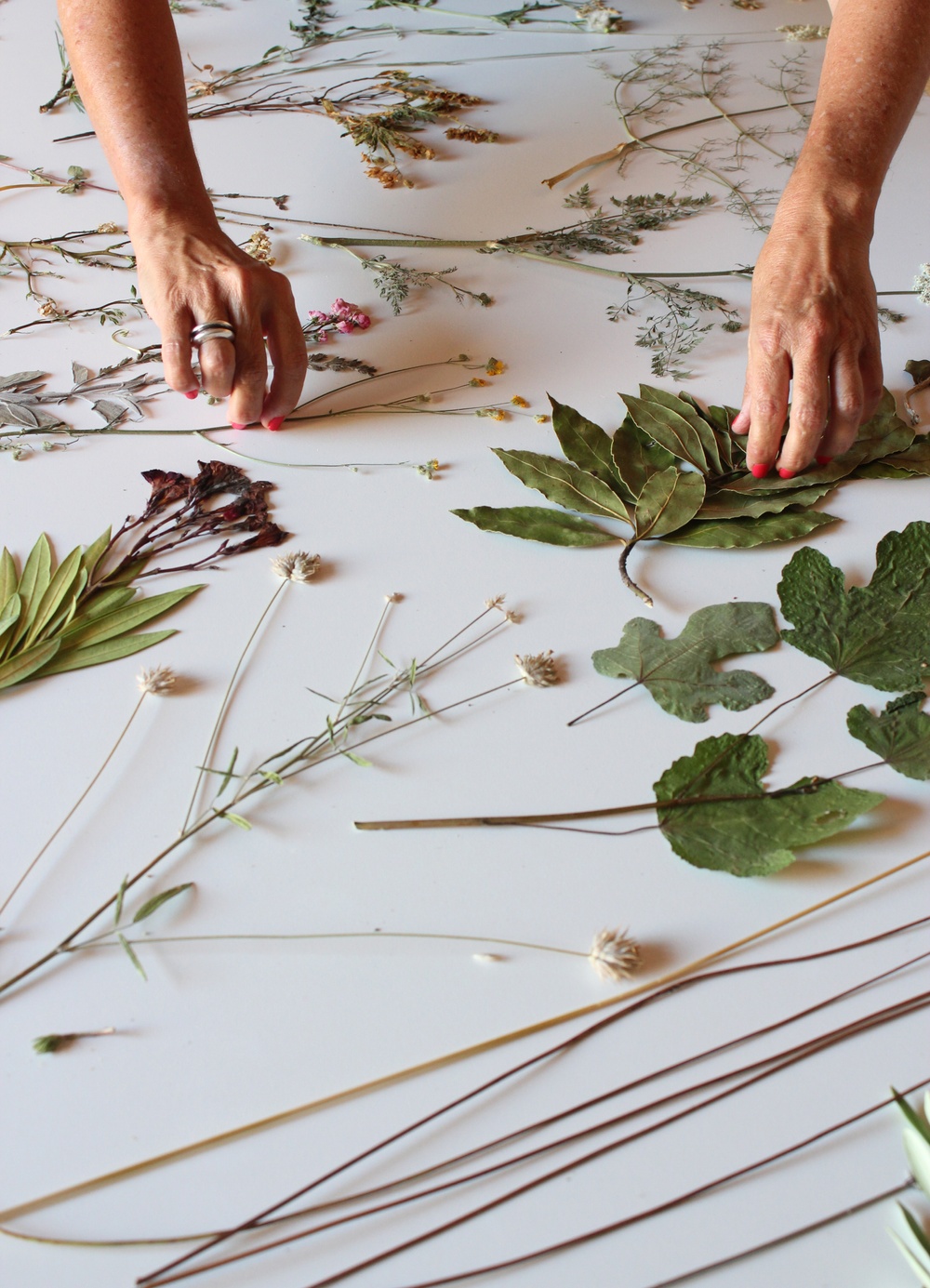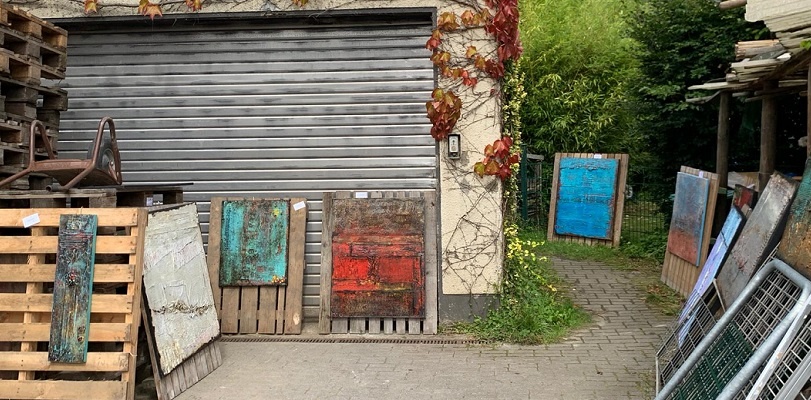Barbados based Annalee Davis was one of the first artists invited to Focus Foundation’s newly established residency in the summer of 2022. Located in a historic farm building in the vicinity of Girona, Spain, Davis used her time at the residency to develop a project for Sharjah Biennale 2023 that links the use of medicinal plants in Barbados, the Mediterranean and Sharjah in UAE.
Alumni Annalee Davis Plants Healing Garden for Sharjah Biennale 2023
In her work she explores how colonialism and slavery changed landscapes, and how disalienation can be achieved through craft and planting. Her garden becomes both a repose for the soul and for communities as well as a living apothecary of healing plants. Find out more about the work Pray to Flowers – A Plot of Disalienation, which is being developed for Sharjah Biennale 2023 which opens in February 2023, in the Q & A.
Her project, a garden for Bait Al Hurma (A Woman’s House), is in line with the ethos of Focus Foundation, its multidisciplinary residency encourages artists to explore local craft, the landscape and community in their practices.
About Annalee Davis
Annalee Davis‘ hybrid practice is as a visual artist, cultural activist, and writer. Her work sits at the intersection of biography and history, focusing on post-plantation economies by engaging with a particular landscape of Barbados. Her studio, located on a working dairy farm operated historically as a 17th-century sugarcane plantation and offers a critical context for her work. Drawing, walking, making (bush) teas, and growing living apothecaries, Davis’ practice suggests future strategies for repair and thriving while investigating the role of botanicals and living plots as ancestral sites of refusal, counter-knowledge, community, and healing.
Recent exhibitions include the group show “Vanishing Lines“ in Venezuela, and “A Hymn to the Banished“ at Balmacara’s Steadings Gallery on the Lochalsh estate as part of a year-long commission for the National Trust for Scotland exploring historical links between Scotland and Barbados. She is currently working on a living apothecary for the Sharjah Biennale opening in February 2023 and The Garden of Hope at Walkers Reserve on the East Coast of Barbados. Other exhibitions include “lightly, tendrils” (CCA Glasgow); “Staple: What’s on your plate?”, an inaugural show at Haay Jameel (Jeddah); “And if I devoted my life to one of its feathers?” (Kunsthalle Wien, Austria); and “Potential Agrarianisms: Will there be sugar after the rebellion?” (Kunsthalle Bratislava, Slovakia). Summer of 2022 she took part in the Focus Foundation residency at Mas las Heras/Girona, Spain.
Q & A With Annalee Davis
Pray to Flowers – A Plot of Disalienation for Sharjah Biennale 2023.
Q How and when did you start thinking about this project that developed into Pray to Flowers – A Plot of Disalienation?
A In 2021, Sharjah Biennale’s Director, Hoor Al Qasimi, visited my studio in Barbados, inviting me to make new work in Bait Al Hurma’s (A Woman’s House) limestone courtyard and adjacent interior room. The biennial’s theme, Thinking Historically in the Present, offered a perfect opportunity to build on my earlier work (bush) Tea Plot–A Decolonial Patch and I immediately knew that I wanted to grow a living apothecary as a post-COVID refuge. Pray to Flowers – A Plot of Disalienation considers how detached society has become from the natural world and how polarised many communities are. Disalienation suggests that a deeper connection with the vegetal world and with one another is possible and necessary.
Q Could you tell us about how plants have been a driving force in “conquering” the world – such as bioprospecting – and changing local habitats by monoculture through sugar cane plantations across the Caribbean?
A The British Empire introduced mono-crop farming practices and plantations to the British West Indies, including Barbados–its first sugar isle. On arrival, they met an island rich in biodiversity that they chose to almost completely eradicate by the third quarter of the 17th century. The colonial machinery’s extractive policies in the Caribbean modernized Britain, which became the first industrial nation in th e world and grew to control almost a quarter of the globe by the early 20th century. This colonial regime included taking West Indian plant species to Britain’s botanical gardens to grow their knowledge and economy. They also transplanted millions of people to the region– as mere cogs in the spinning wheels of the global marketplace.
In Praise of Plants, work in progress, Annalee Davis 2022. Courtesy of the artist and Focus Foundation, Girona, Spain
Q How do you connect the Caribbean and your home in Barbados, the Mediterranean, and Sharjah in UAE on the Persian Gulf in terms of landscape and colonialism?
A The physical landscapes of the UAE and the Mediterranean are quite different from that of Barbados, but they all have increasingly fragile ecosystems. Eighty percent of the UAE is desert and, similar to Barbados, is a very water-scarce region. Like the Mediterranean, vulnerability to climate change means we all experience hotter temperatures, less rainfall, more storms, and hurricanes. While in Spain this past summer at a residency at Focus Foundation the temperature was higher than usual as was the case in Sharjah this past November. Barbados’ dry and wet seasons are misbehaving and the hurricane seasons are increasingly active. These disparate locations are connected by the sixth extinction.
While Barbados abolished slavery in 1834 the UAE didn’t do so until 1963 creating deeply stratified societies which the Caribbean has been addressing, in part as a post-independent nation advocating for reparations. The UAE was a British protectorate until 1971 while Barbados was a British colony until 1966 becoming the world’s youngest Republic in 2021. The Spanish Empire’s longest colonial presence in the Caribbean lasted for four centuries across Cuba, the Dominican Republic, and Puerto Rico establishing some of the regions’ oldest sugar industries. Being on the receiving end of colonial expansion in the Caribbean means we got the bible while the British and Spanish colonial regimes left the New World with gold, tobacco, cotton, and sugar in hand. Different routes to heaven, I guess.
Q In November 2022 you traveled to Sharjah to plant jasmine, then sugar cane, banana plants, and medicinal plants. Tell us about the idea behind the garden and your collaboration with Yoeri Guépin.
A This garden builds on the history of marginal plots of land inside the plantations given to enslaved African people to grow food, practice ritual, make medicine or poison, and take care of their community. Pray to Flowers – A Plot of Disalienation is a post-plantation living apothecary recognizing how the natural world is threatened, and, rather than reflect the geometry of the plantation is inspired by bio-diverse counter-landscapes honouring healing traditions maintained by the indentured and the enslaved people, suggesting future strategies for repair, thriving and connection.
Yoeri Guépin and I met at a summer seminar at Stiftung Kuenstledorf in Germany where he developed a vernacular, edible garden collaboratively with other resident artists there. His lineage of biodynamic farming parents and grandparents provide him with a deep knowledge of ecology and his intuitive wisdom of the vegetal world is encyclopedic. Inspired by his spirit, his personal seed bank of 600 species, and his ten green thumbs, I invited him to grow the apothecary with me in Sharjah. We have since developed a wonderful reciprocal relationship and are excited to share the result of our labour of sowing over 150 different plant species in February 2023.
Q The garden will have plants for making Bush Tea. What is Bush Tea and how is it connected to the landscape and society in the Caribbean?
A Spirit-based rituals and healing methods survived the forced migrations of human beings transplanted from around the world to the Caribbean beginning in the 17th century. The Caribbean landscape is infused with ancestral knowledge systems critical for endurance and defiance of inhumane conditions. Given the nascent stage of medicine during the colonial period, illnesses were treated with what people had access to – botanicals.
In Barbados, bush teas, baths, and medicines were part of an oral pharmacopoeia, including charms and incantations uttered to release the healing power of plants. Herbal medicine, belittled by the use of the term “bush”, these medicinally valued plants supported people through the terrors of their dislocation, offering a balm to their weary or diseased bodies and shattered spirits.
Q The garden will be a living apothecary. What plants used for healing are typical of the tradition and landscape of Sharjah?
A Typical herbs used in the UAE region include turmeric, cumin, oregano, coriander, castor, thyme, fenugreek, cinnamon, neem, aloes, sage, dates, frankincense, fennel, gum Arabic, mint, garden cress, nigella and harmal seeds among many others. Several people shared their memories with me of a mixture of dates and turmeric as an anti-inflammatory poultice. I enjoyed drinking the potent zaatar tea made using fresh marjoram, thyme, and oregano known for its antiseptic benefits, aiding digestion, and helping the immune system.
Q Summer of 2022, you spent time at Focus Foundation’s residency in Mas las Heras, Girona, Spain. What part of the project was developed at Focus Foundation and how did you establish connections between that landscape and its socioeconomic history and Sharjah and Barbados?
A While at Focus, I had the time to read and imagine my contribution to SB15. I started thinking about making embroidered drawings–a new method developing in my practice–wanting to display them in a space adjacent to the living apothecary. Focus gave me the time to face my fear of embroidering–a leftover trauma from failing sewing class in secondary school–so I told myself it was simply drawing with thread. The first words I embroidered were Pray to Flowers. They have since been appliqued onto one of five large, embroidered drawings to be shown at SB15.
Similar to Barbados and its history of rebelling against slavery conditions, Las Heras has a subversive history of resistance–its first owners were peasants who participated in an uprising against feudal power advocating for their freedom and social justice. During my limited time in Sharjah, I was treated most hospitably and the Emirate felt safe and gentle to me as a guest artist moving from the artist’s flat to the courtyard. However, I became aware of the surveillance of the wider social space and of how migrant workers endure exploitative labour systems tying them to their employers. Rebelling, or striking is illegal in the UAE given the kafala or sponsorship system that ties labour to the employer.

Q What is the project giving to Sharjah and its community and will it be a permanent installation?
A Sharjah’s entire diverse community will be welcome to appreciate the living apothecary as a site of disalienation. Together with the adjacent interior space showcasing the embroidered works and an active seed bank, there will be moments to gather, engage in dialogue and drink healing teas. Participation in the workshop programme in the courtyard next door will further activate the project by sharing different systems of knowledge around building compost, growing small home gardens, making teas, and cyanotype workshops for young people and their families. A conversation with fellow artists about tea-drinking traditions grounded in their histories will inform tea recipes to be shared with the Sharjah Art Foundation’s Fen restaurant and available during the biennial. I hope that the apothecary will be adopted locally and nurtured for years to come.
Q Knowledge of plants and their use in healing as well as certain crafts such as embroidery is often found among women and transferred from generation to generation without written records. How did you go about researching in the different locations, Barbados, Mas las Heras and Sharjah?
A Ignasi Bau Erra, the caretaker of the grounds at Focus Foundation, shared his Catalan book of healing plants with me and identified unfamiliar botanicals growing in the surrounding grounds. He taught me about the perennial stonecrop succulent plant that Catalonian farmers place in cow’s drinking water for its mineral value and spoke about fennel’s use as a digestive and to marinate snails.
While in the UAE, I had the privilege of meeting Dubai-based, Bedouin elder and healer, Umm Saeed, who received knowledge from her father and grandfather. Some of her remedies were complex combinations of up to twenty-eight dried herbs addressing a wide range of ailments including diabetes, cholesterol, fertility issues, kidney stones, gallbladder issues, and much more. In Sharjah, I met with the Irthi Crafts Council which is preserving and modernising Emirati cultural traditions. They will offer workshops as part of my wider project. And I am collaborating with Ajman-based ceramicist, Hessa Aljamani on a unique tea service.
In Barbados, alternative knowledge systems were conveyed orally as bush medicine in spirit-based, Afro-syncretic practices were illegal until the 20th century. More scholarship is happening but documentation is hard to find so my primary research includes speaking with practitioners and forming relationships within local communities.
Q Is the main audience in Sharjah for Pray to Flowers women from the local community and if so, how will you reach them?
A Sharjah is populated by more than two hundred nationalities while less than twenty percent of the population is Emirati. Pray to Flowers is intended as a site of disalienation and everyone is welcome to take refuge in the apothecary- whether from any of the seven Emirates or further afield like those I met from India, Egypt, Pakistan, Nepal, Ghana, Uganda, Iraq, the Ukraine, Kazakhstan or Russia. People from these countries would often visit Yoeri and me while we were sowing seeds or I was painting topographic lines on the wall of the courtyard, recognising plants and sharing their medicinal uses in their home countries. The aim is to reach people through public programming which includes women-focused workshops on reproductive and post-reproductive care using herbs, an introduction to Talli embroidery, dyeing with plants, or a tea-making workshop for women’s wellness among others.

Q In a world of turmoil, what can we learn from this project and incorporate into our everyday lives wherever we live in the world?
A In response to the existential crisis on a global scale, the planet is begging us to develop a different relationship with the natural world. Rather than continuing to violate the earth, we can choose relationships of mutuality, regenerate our local spaces, and love the grounds beneath our feet, wherever they are. I am hopeful that visitors who spend time in the living apothecary will find moments to pause and be inspired by the potential of small green spaces, connect with others who are motivated to defend the natural world, grow more gardens and give birth to a greener world that can breathe more easily. The architecture of our past does not have to be the blueprint of the future. It’s not complex. We know what to do. Just plant a seed.
More Informations
Artist Website: About — Annalee Davis
Events selected by us can be found under >>> Events <<<
You can find our interviews here: Interview | Arttrado.de
If you want to tell us about your exciting art project, use our contact.
If you like ARTTRADO, you can support us.





